Day 2 of a three day long weekend of Autumn Migration Tours today. It was a nice bright start to the day, but the wind increased during the morning as ‘Storm Brian’ swept across the UK. Thankfully, being on the east coast, it was nowhere near as windy here as it was in the west of the country, but it was still rather gusty at times. It clouded over a bit too, in the afternoon, but remained dry all day and we had a good day out.
Given the nice weather first thing, we decided to have a quick look in Wells Woods to see if any migrants had arrived overnight. There are lots of Little Grebes now on the boating lake – we counted at least 17 as we walked past – but no ducks other than the local Mallards.
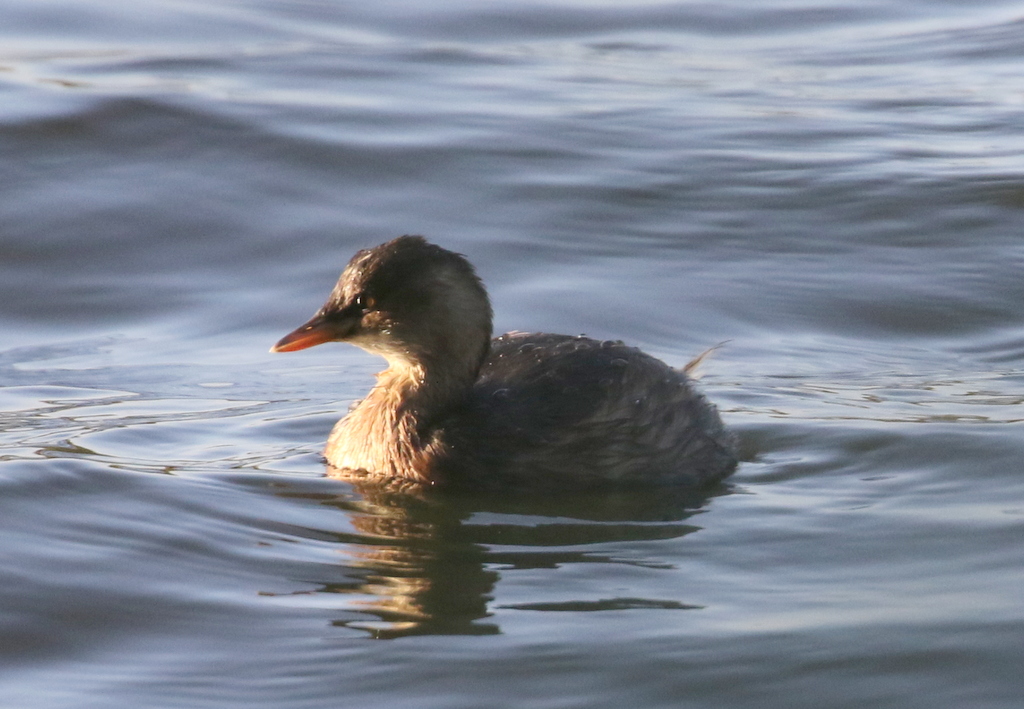 Little Grebe – one of at least 17 on the boating lake today
Little Grebe – one of at least 17 on the boating lake today
We set off into the woods but it was quiet at first in the trees. We could hear Long-tailed Tits calling further over, towards the east side of the Dell. On our way round there, a Treecreeper flew in and landed on the trunk of a large old pine tree in front of us. We watched it for a minute or so as it picked its way around the furrows in the bark, before it disappeared round the other side of the tree.
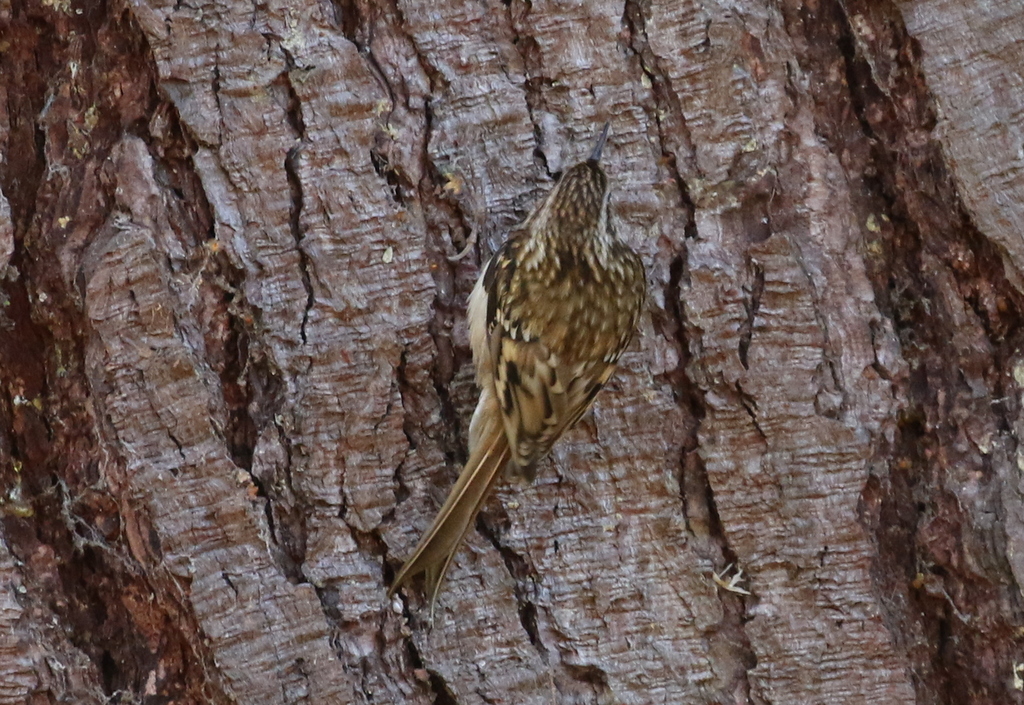 Treecreeper – flew in to the trunk of an old pine tree in front of us
Treecreeper – flew in to the trunk of an old pine tree in front of us
At first we could only find three Long-tailed Tits together. They were calling constantly and had possibly lost the rest of the flock. They disappeared off the way we had come, but as we walked out onto the main path, we found the rest of the group. They were in a sheltered spot initially, but quickly moved round to the breezier side of the trees where they were harder to follow.
The tit flock was on the move, and didn’t seem to know which was they were going, They first started to head over to the caravan site, then changed their minds and went back to the edge of the Dell, before starting to fly over to the west side of the meadow. There was a nice selection of the commoner tits and a few Goldcrests, but it was hard to see the whole flock. In the end, they disappeared into the trees and we left them to it.
The bushes in the more open areas by the track still held a few thrushes – several Blackbirds and a Redwing or two – plus a handful of Chaffinches, but not the number of migrants that they have produced in the last few days. It seemed like there had not been much in the way of new birds in overnight, and earlier arrivals had already mostly moved off inland. A Bullfinch flew out of the brambles and away ahead of us, flashing its white rump. There were a few Curlews in the nearer fields, and we could see small flocks of Pink-footed Geese dropping into the fields further south.
The drinking pool seemed like a good place to check, as it would be relatively sheltered. As we walked in, we could hear Long-tailed Tits calling in the pines beyond, but it took us a while to locate them. Thankfully, they worked their way round to the pool and many of them dropped down into the smaller trees round the edge. We had great views of the tits and in particular a couple of Goldcrests which were feeding low down right in front of us.
 Goldcrest – one of several feeding in the bushes round the drinking pool
Goldcrest – one of several feeding in the bushes round the drinking pool
As the tit flock moved back up into the pines, we decided to make our way back and try our luck elsewhere. The wind had already started to pick up now, and we really noticed it as we got out of the trees. When we got back to the car, we headed off east along the coast to Cley.
There has been a Black Redstart hanging around here for a few days now and today it had taken up residence on the roof of the wardens house. As we walked out to the hides, we could see it flitting around on the tiles. The sun was on the east side of the roof, which was also most sheltered from the wind. Presumably it was finding insects up there because, as well as the Black Redstart, there were also two Pied Wagtails on the roof.
 Black Redstart – on the roof of the warden’s house at Cley
Black Redstart – on the roof of the warden’s house at Cley
Black Redstarts breed in small numbers in Norfolk, mainly around Great Yarmouth. This one is presumably a migrant, heading from the breeding grounds in northern Europe to winter around the Mediterranean.
The boardwalk out to the hides was also in the sun, and sheltered from the wind by the tall reeds either side. There were lots of Common Darter dragonflies along here, basking in the sunshine on the bare wood.
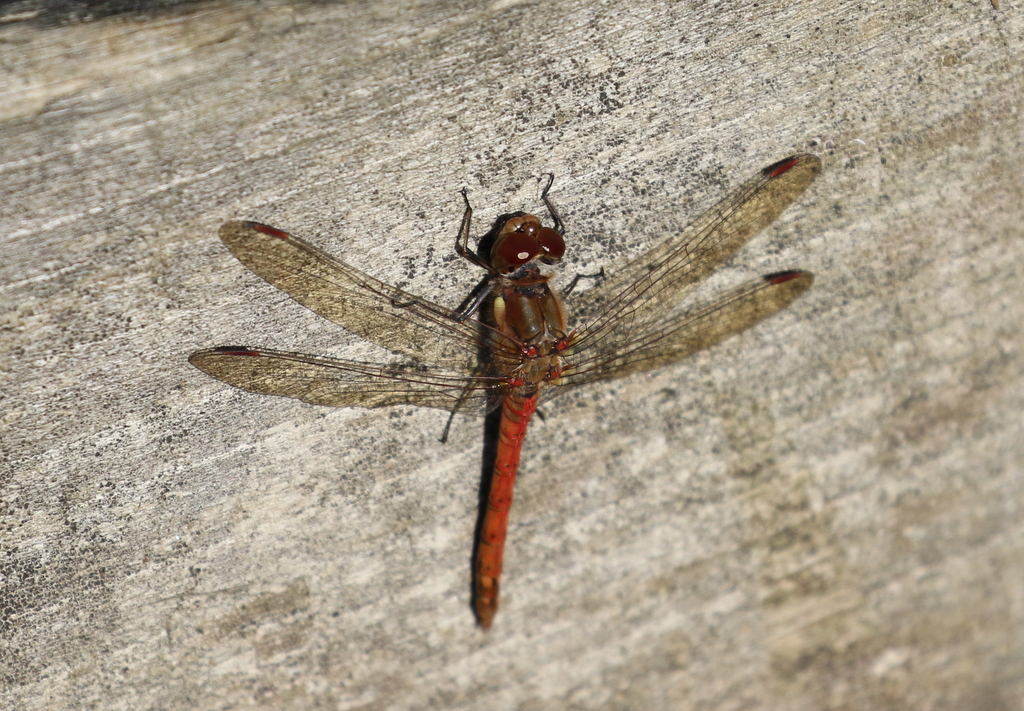 Common Darter – basking in the sun along the boardwalk
Common Darter – basking in the sun along the boardwalk
At the end of the boardwalk, we headed for Dauke’s Hide first. There were lots of ducks out on Simmond’s Scrape – mainly Wigeon and Teal, now returned in larger numbers from Russia and northern Europe for the winter. They were very jump in the wind, and kept flying up into the air, taking everything else up with them, before landing again.
There have been good numbers of Little Stints at Cley this autumn and the same was still true today. There were at least 7 on Simmond’s Scrape while we were there, although they were hard to count. They really are tiny birds and were easily lost from view among the ducks or around the back edges of the islands. They were all juveniles – amazing to think they are making their way unguided from the Arctic down to Africa for the winter.
 Little Stint – a juvenile, one of at least 7 on Simmond’s Scrape
Little Stint – a juvenile, one of at least 7 on Simmond’s Scrape
There were not so many other waders on here this morning. This might be partly due to the ducks, which caused them all to take flight several times when we were there, not helped by the two Marsh Harriers which were quartering over the reeds most of the time but would occasionally drift over the edges of the scrapes, presumably enjoying the mayhen which ensued.
There were three Black-tailed Godwits feeding in the deeper water along the edge of the scrape, and a couple of Ruff in among the ducks. A little group of Dunlin included some already in winter plumage and a couple of juveniles with black spotted bellies. A lone adult was still sporting most of its large black belly patch, a remnant from its breeding plumage. A single Common Snipe flew in and landed in the cut dead reeds in the back corner, where it immediately became very difficult to see!
There had been a Curlew Sandpiper reported here earlier, but we couldn’t find it – presumably it had flown off at some point, when all the ducks flushed. We did find a Ringed Plover out on the grass in the middle of one of the islands. When something else landed with it, we looked over and were surprised to see a dumpy, much darker wader – a Purple Sandpiper.
Through the scope, we could see the Purple Sandpiper’s yellow legs and bill base. It was a first winter bird, still with its retained pale-fringed juvenile wing coverts. It stayed just long enough for us all to get a good look at it through the scope. Then suddenly all the ducks erupted again, as the Marsh Harrier drifted across the back of the scrapes, and the waders took to the air too. Unfortunately, despite most of the birds quickly returning to the water, the Purple Sandpiper had disappeared.
One of the smartest birds on here today was a Starling. We don’t tend to look at them as much as we should, as they are not uncommon here especially in winter, but this one was probing in the grass for invertebrates, on the bank right in front of the hide, and demanded our attention. It looked particularly striking in its fresh plumage, with striking white or pale brown tips to the feathers head and body feathers. A real stunner!
 Starling – feeding in the grass in front of the hide, a stunning bird close-up
Starling – feeding in the grass in front of the hide, a stunning bird close-up
There are not so many birds on Pat’s Pool at the moment, but we popped into Teal Hide for a quick look. The highlight was a single Avocet in a line of roosting Black-headed Gulls and Ruff. Most of the Avocets here have left already, but there are still a very few hanging on along the coast. There seem to be fewer than recent years, so perhaps they know something we don’t about the coming winter!
The Ruff here today were mainly juveniles, faded now to a variety of pale, buff, stone, ecru underparts. A single winter adult with them was much paler, whitish below, and with obvious bright orange legs and bill base.
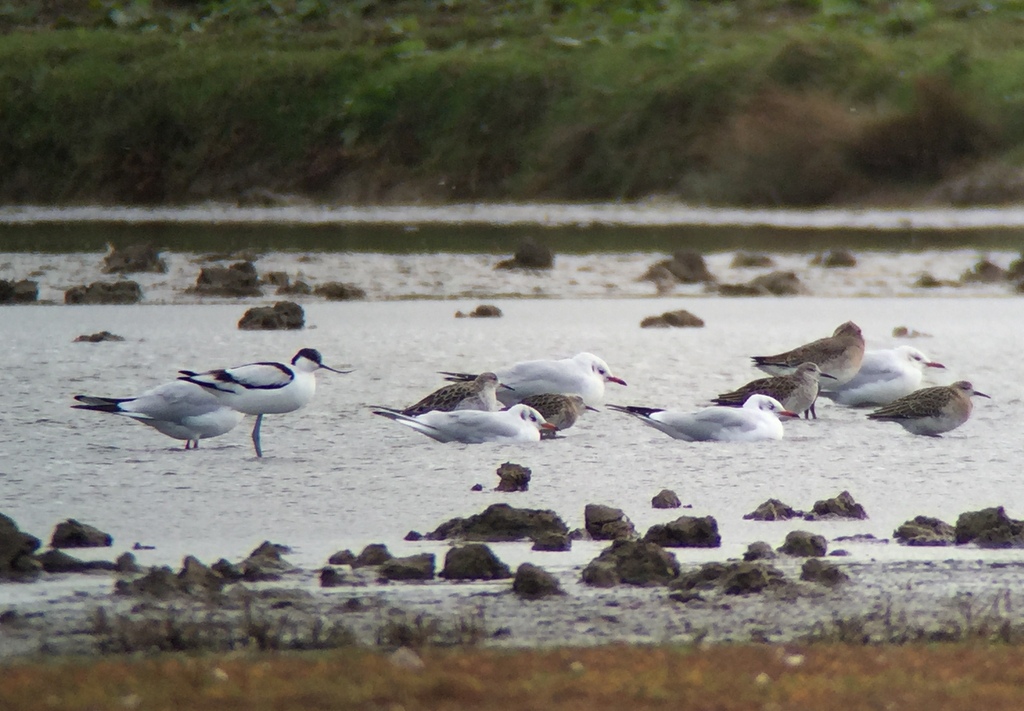 Avocet & friends – with a few Ruff and Black-headed Gulls
Avocet & friends – with a few Ruff and Black-headed Gulls
Then it was back to the visitor centre for lunch. It was rather windy now, but not enough to stop us from making the use of the picnic tables and enjoying the view across the reserve.
After lunch, we made our way round to the beach car park. As soon as we got out of the car, we could see a small group of Brent Geese in the Eye Field. There was a Black Brant here a couple of days ago and a quick glance through the flock revealed an obviously different bird – much darker, blackish bodied, than the accompanying Dark-bellied Brents, with a brighter, cleaner white flank patch. A smart Black Brant.
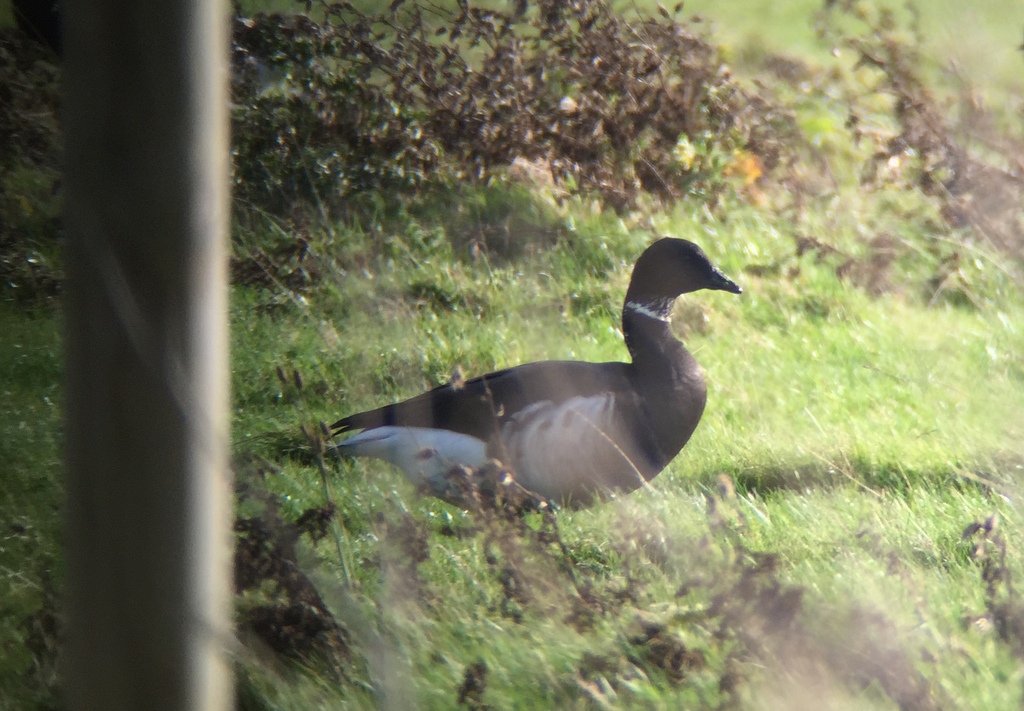 Black Brant – with the Brent Geese in the Eye Field
Black Brant – with the Brent Geese in the Eye Field
This was our second Black Brant in two days, presumably another returning individual, which has got attached to a group of Dark-bellied Brents in Siberia and now remains with them all year, migrating back and forth to Norfolk. It didn’t appear to have such a strongly marked neck collar as yesterday’s Black Brant at first, but it was feeding and hunkered down against the wind. When it lifted its head, the extensive neck collar, connecting under the chin and almost joining at the back of the neck, was more obvious.
There had been several Gannets circling offshore earlier, we had seen them distantly from the hides before lunch, so we had a quick look out to sea. Unfortunately they had moved further offshore or along towards Salthouse now – we could still see them, a mixture of black-tipped white-winged adults, dusky grey juveniles and some in betweens. Otherwise, there was not much happening out to sea, no wildfowl moving today. We did see a few distant auks, Guillemots and Razorbills, flying past.
To finish off our visit to the reserve at Cley today, we headed round to the East Bank to head out to Arnold’s Marsh. It was rather windy up on the East Bank, but the wind was at our backs on the walk out. We could just about hear the Bearded Tits calling at the back of Don’s Pool, but it was not the day to be looking for them today – Bearded Tits don’t like the wind, and typically remain tucked deep down in the reedbed on days like today.
There was a good smattering of ducks out on the grazing marshes to the east as we walked out, mostly Wigeon and Teal. Looking through more carefully, we found a few Pintail asleep in the grass and a few Gadwall too. Several juvenile Ruff were feeding on the mud at the north end of the Serpentine.
We took shelter from the wind in the shelter overlooking Arnold’s Marsh. There was a nice selection of waders out on the water here, mostly Black-tailed Godwits and Redshanks along with several Curlew. Around the edges and the islands we found three Ringed Plovers and two Grey Plovers. Then it was a brisk walk back into the wind!
For our final stop, we finished the day with a visit to Kelling Water Meadow. As we walked up along the lane, we could hear a Chiffchaff calling from deep in the hedge. Several Blackbirds flushed ahead of us from where they were feeding on the berries, as we saw this morning, probably birds lingering having arrived over the last couple of days.
There had been a Yellow-browed Warbler reported from the copse here earlier and we arrived to find a small crowd leaving. We were told it had been in the hedge on the sheltered north side and after only a minute or so it appeared among the leaves. It flitted about for a while, long enough for us to get a good look at it, before it disappeared back into the trees as a flock of tits moved through.
Continuing on down to the Water Meadow, we stopped at the gate on the cross track and looked back over the pool. Three small waders on the mud were the three lingering juvenile Curlew Sandpipers, so we had a good look at those through the scope. A little bigger and sleaker than a Dunlin, with a longer, more downcurved and Curlew-like bill, cleaner white and buff below with delicately scaled upperparts. They have been around here for a while now, stopping off to feed on their way down from the breeding grounds in central Siberia to Africa for the winter. Presumably they will be on their way again sometime soon.
Further back, in the most distant corner of the pool, we could see a couple of larger waders and through the scope, we could see that they were two Spotted Redshanks. These birds have been lingering here for several weeks now too. Like the Curlew Sandpipers, they are both young birds, reared in the Arctic in the summer and now making their way south. There were a couple of Common Snipe feeding with them, but there was another Common Snipe closer, on the edge of the island, which we got a better look at. There have been one or two Jack Snipe here in recent days, but we couldn’t find them today.
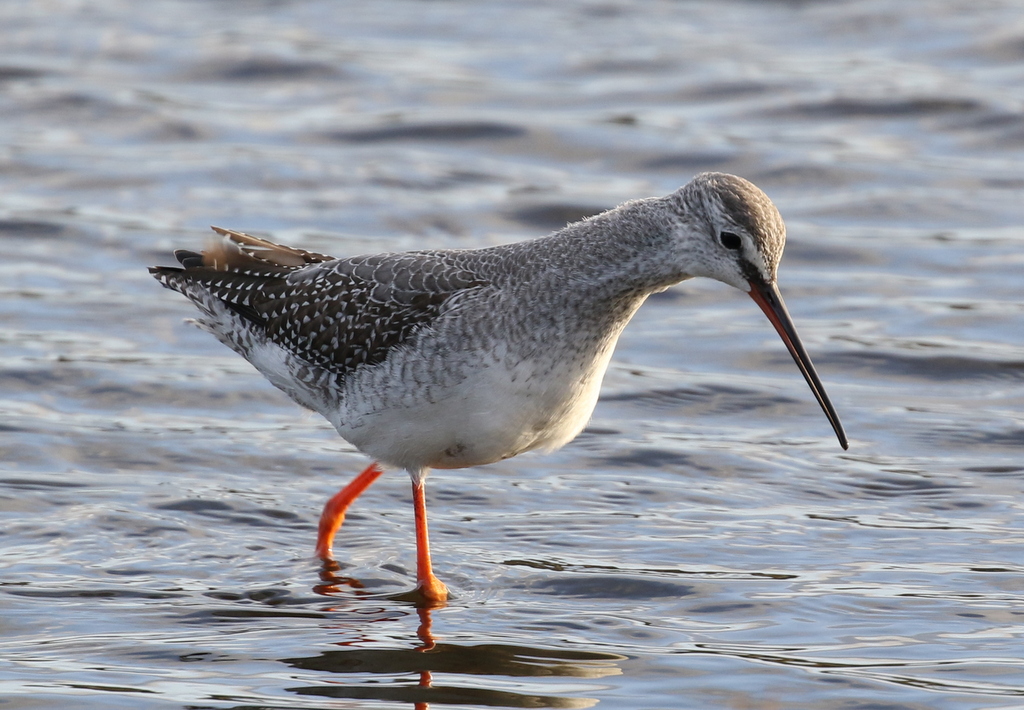 Spotted Redshanks – gave great close views after everyone else had gone
Spotted Redshanks – gave great close views after everyone else had gone
One of the Spotted Redshanks is much paler than the other – the paler one is more advanced in its moult, with more silvery grey moulted first winter feathers in its mantle and scapulars. The second bird is now starting to moult and we could see a smattering of new feathers here, but it still appears rather dusky by comparison.
There were a few other birds here too, while we stood and watched the waders. A Fieldfare flew past behind us and we caught it as it continued on west, over the hill and into the sun, the only one of the weekend. A flock of Linnets flew across the Quags calling and a Stonechat zipped across and disappeared over the hedge.
The Spotted Redshanks made their way along the east side of the pool and down towards the top corner, so we made our way along behind the reeds and were soon treated to great close-up views of them as they fed just a few metres away from us. We could see their long, needle-fine bills, with a slight kink at the tip. They were feeding busily, in and out of the grass around the edge of the pool.
Then it was time to head back. The nights are drawing in now and the light was already starting to fade as we wended our way along the coast road to finish the day.
















